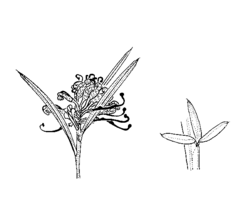Grevillea patulifolia Gand. APNI* Synonyms: Grevillea linearifolia 'southern sandstone form' of Makinson (1991) APNI*
Grevillea linearifolia form 'f' (southern sandstone form) of McGillivray & Makinson (1993) APNI*
Grevillea parviflora of Fairley & Moore (1989) APNI*

Description: Erect or low spreading shrub 0.8–2 m high, often rhizomatous.
Leaves ± linear to narrow-elliptic to slightly oblanceolate, mostly 2–5 cm long and 1–3 mm wide, pungent; upper surface dotted, veins prominent and granular to scabrid; margins angularly refracted, lower surface exposed and subsericeous or mostly enclosed and 2-grooved.
Conflorescences often aggregated, regular-umbelloid or occasionally broadly secund, usually many-flowered. Perianth pale pink to dark mauve-pink or rarely white, subsericeous outside, bearded inside. Gynoecium usually 8–8.5 mm long; ovary glabrous; style gently curved with a sharp terminal hook, minutely hairy or papillose in apical 1 mm; pollen presenter oblique.
Follicle glabrous.
Distribution and occurrence: Grows in moist heath or eucalypt woodland on sandy soils; on the coast south from Heathcote to Ulladulla and inland to the adjacent ranges, scattered in the CT.
NSW subdivisions: CC, SC, CT, ST
Other Australian states: Vic.
Text by R. O. Makinson
Taxon concept: R.O. Makinson (2000)
APNI* Provides a link to the Australian Plant Name Index (hosted by the Australian National Botanic Gardens) for comprehensive bibliographic data
***The AVH map option provides a detailed interactive Australia wide distribution map drawn from collections held by all major Australian herbaria participating in the Australian Virtual Herbarium project.
|


